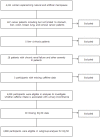Caffeine Intake Is Associated with Urinary Incontinence in Korean Postmenopausal Women: Results from the Korean National Health and Nutrition Examination Survey
- PMID: 26901426
- PMCID: PMC4762759
- DOI: 10.1371/journal.pone.0149311
Caffeine Intake Is Associated with Urinary Incontinence in Korean Postmenopausal Women: Results from the Korean National Health and Nutrition Examination Survey
Abstract
Introduction: The objective of this study was to investigate whether caffeine intake is associated with urinary incontinence (UI) and quality of life (QOL) in Korean postmenopausal women.
Materials and methods: We included 4,028 postmenopausal women who had participated in the Korea National Health and Nutrition Examination Survey IV (KNHANES IV). From the KNHANES questionnaire data, we ascertained the UI status of participants, defined as self-reported or medically diagnosed UI, and calculated their total daily caffeine intake through questions regarding the frequency of food consumption. The EuroQoL-5 Dimension (EQ-5D) descriptive system was used to evaluate QOL among the study population.
Results: The mean age of the study population was 63.19±0.25 years. Among the 4,028 women, the prevalence of medically diagnosed UI was 2.6% (n = 151), the prevalence of self-reported UI was 11.9% (n = 483), and the lifetime prevalence of UI was 15.8% (n = 639). In the study population, the presence of UI was not significantly different by age group, but daily caffeine consumption and the percentage of caffeine consumer decreased with age (P<0.001). Higher caffeine intake led to significantly higher prevalence of both medically diagnosed UI (p = 0.012) and self-reported UI (p = 0.040) in the study population. Even after adjusting for factors including age, parity, smoking status, hypertension and diabetes in logistic regression analysis, the positive association between caffeine intake and UI prevalence was observed in both medically diagnosed UI and self-reported UI (P = 0.017) among participants. In a subgroup analysis for EQ-5D (using continuous variables) in which we categorized participants into four groups according to UI presence and caffeine consumption, the EQ-5D scores were lower in the caffeine non-user group with UI than in the caffeine consumer group with or without UI.
Conclusion: In a sample of Korean postmenopausal women, the prevalence of UI increased with higher caffeine consumption. Additionally, QOL was lower in caffeine non-users with UI than in the caffeine consumer groups. However, additional prospective studies are required to identify clear causation between caffeine consumption, UI prevalence and QOL.
Conflict of interest statement
Figures


References
Publication types
MeSH terms
Substances
LinkOut - more resources
Full Text Sources
Other Literature Sources
Medical

